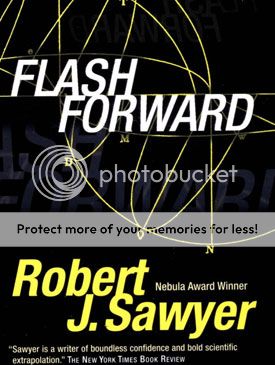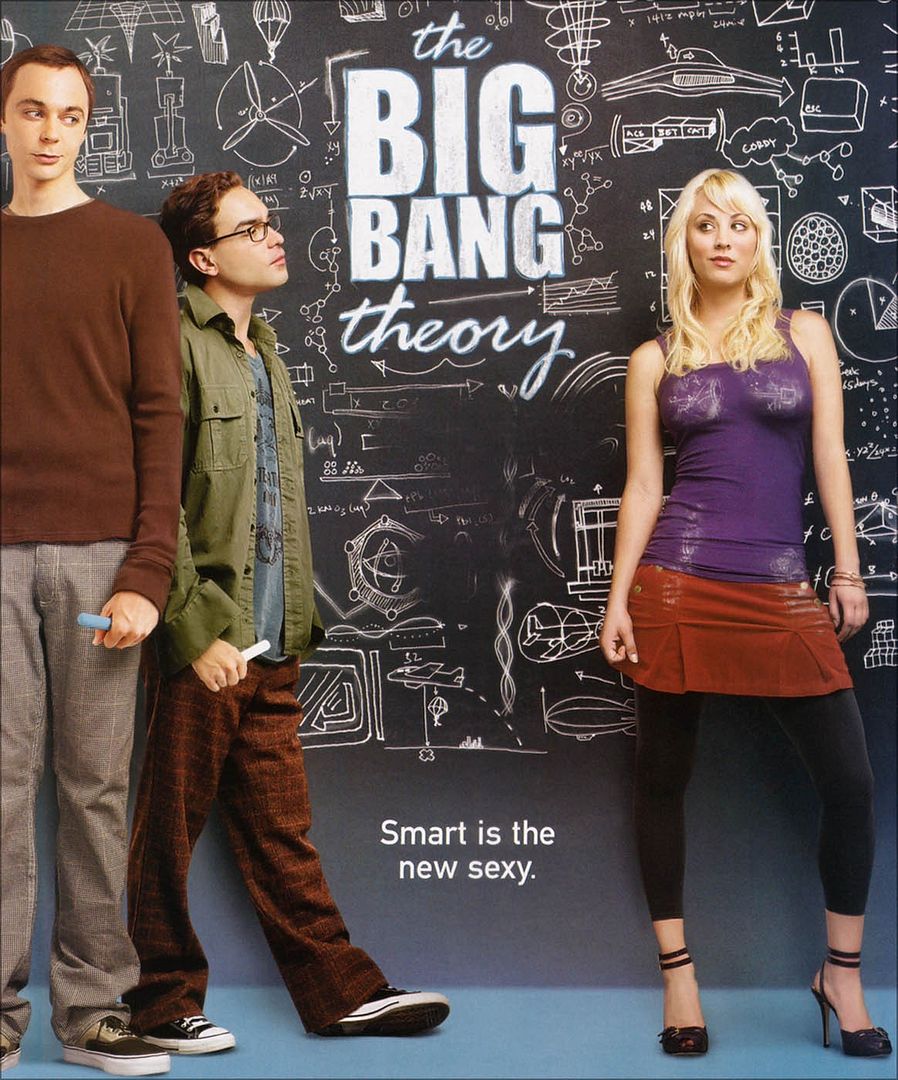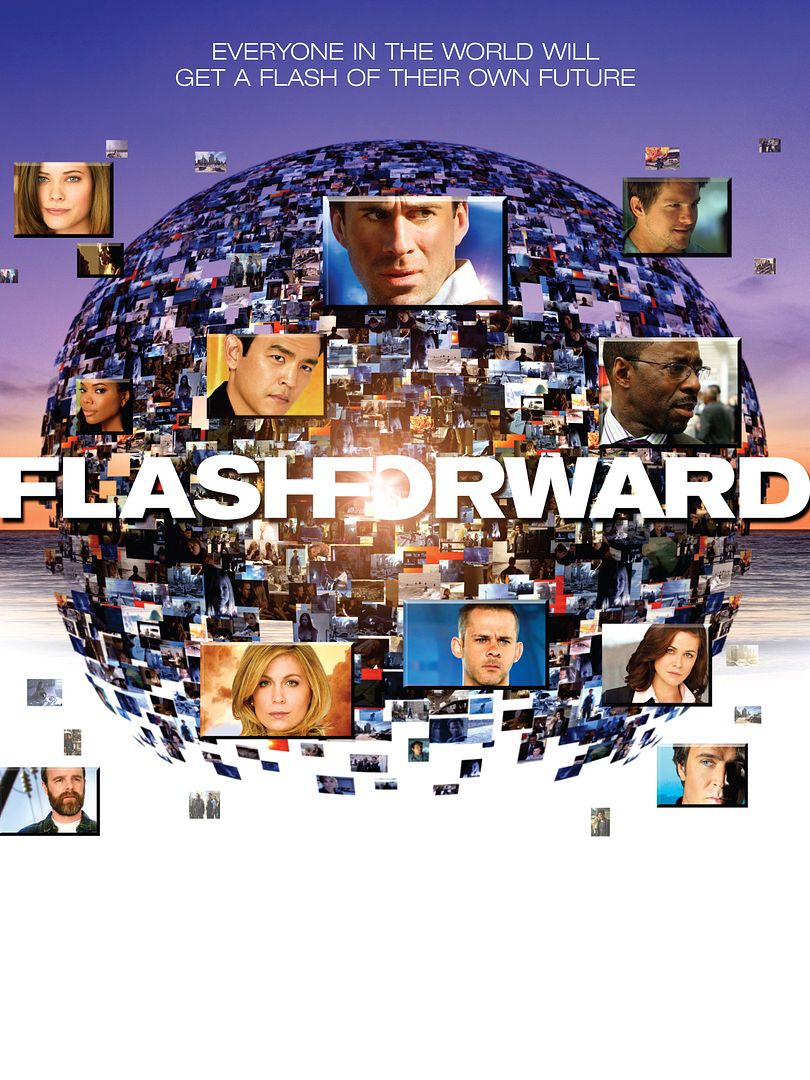FlashForward: Illogicalifragilisticexpialidocious

It goes without saying that pretty much every work of fiction begins with the “what if” question. “What if I knew the world was ending tomorrow?” “What if my wife was secretly plotting to kill me?” “What if this article wins me the Pulitzer?” What separates the great (or simply enjoyable) work from that which cannot be accepted is a second level of consideration: actually thinking about the “what if” and seeing if it has any real value, any weight, beyond that first fleeting thrill that comes with the High Concept. FlashForward, the ABC TV series or the 1999 novel by Robert J. Sawyer upon which it is loosely, loosely based, is a perfect example of exactly that: the cool but ultimately unsatisfying idea that really can’t stand the stress of storytelling. Because hiding behind the spotty acting and cliché characters—on screen or in print—the whole concept has a serious problem: it just doesn’t make a lick of sense. Under the “continue reading” jump, an analysis of the logic and science flaws of FlashForward.
Same Name, Different Game
A quick reading of the novel by Robert J. Sawyer (which is all it warrants) won’t provide you with any background or spoilers on the TV series. In fact, it will only confuse you even more. The two have almost nothing in common:
• Everybody on Earth in 2009 blacks out for a little over two minutes, and everyone experiences two minutes of their own lives at a fixed point in the future
• The world suffers badly during their two-minute absence
• Many characters experience nothing — a void — during the blackout, and assume they are dead
• One character learns he is murdered shortly before the future-point of the “flashforward”
• There’s a lead character named Lloyd Simcoe
…and that’s about it. That’s the entirety of the shared premise, and the heart of the High Concept that empowered it: What if everybody fell asleep at the exact same instant and saw a glimpse of their future lives? Take a look at this Time Magazine video in which Jordan discusses the science behind his premise for the book:
The differences, on the other hand, are literally too numerous to mention, but a few stand out. In the book, the moment the whole world glimpses is twenty years in the future, which makes for some interesting speculations about the financial stability of insurance companies and intellectual property (i.e., inventors developing technology they didn’t actually think of, but saw in action in 2030 and reverse-engineered. Whose idea is that, then?). In the TV series, the moment everyone glimpses is just a few weeks away—April of 2010, seen by the whole world in October of 2009. The cast of characters in the book is entirely different than the series; even the character with the same name—Lloyd Simcoe—is entirely different, right down to his job and his nationality. And where the characters, dialogue, and subplots in the TV series are horribly over-familiar to any savvy viewer of Lifetime Movies of the Week (“Why did you cheat on me?” “Why did you start drinking again?” “How can I, a single lesbian, be pregnant and happy about it?”), the book’s characters are as thin as the paper they’re printed on. They do very little except talk, offering a gaggle of thought-experiments about quantum physics, the universe, and everything, and engaging you on a personal level…not at all. However, the book and series do share one other thing: a central idea that’s so weak and illogical it can’t stand up to any kind of scrutiny.
We want to be Lost
It seems pretty obvious: ABC-TV knew it was about to lose Lost, that dizzying combination of Survivor, The Prisoner, and every bad Solve-It-Yourself mystery you ever read as a preteen, and wanted to introduce a replacement before the the fans of fantasy, high romance and the Drama of Ambiguity wandered away. At first glance, FlashForward must have seemed an ideal candidate: another Mysterious Event involving a group of dramatic characters in interlocking plot lines, with just a soupçon of time travel/fantasy mixed in, swirled together with a constant stream of new characters and plot lines to keep them tuning in every week. The pilot for the series was promising, too (ScriptPhD review): some beautiful and frightening vistas of what would happen to the world if everyone blacked out for 2 minutes and 17 seconds, right in the middle of a busy workday, along with flashforwards that were alternately jarring, mysterious, or even funny. And there were some very talented actors in here, notably Joseph Fiennes and John Cho.
But the real problem, the big problem, with TV show and book alike, is obvious to any thinking viewer by the end of the two-hour pilot or the thirtieth page of the 300-page novel. The premise of both asks the ‘bold’ question, can the future be changed?. And once the audience understands the context of the flashforward, the answer is Yes, it can, at least as far as this plot is concerned.
Think About It, Then Walk Away

That central question is actually answered twice in both the TV series and the book. You can uncover it yourself in just the first few minutes of the experience, or you can wait until halfway through the novel or six episodes into the series to get the confirmation. But it’s right there … and it ruins the whole experience. In the book, Sawyer dawdles all the way to page 145 of the new paperback edition before he reveals the key difficulty with the whole damn idea. An Italian physicist, trotted out on stage just to give this speech, says to our puzzled protagonist:
“Let’s take a look at your premise. Twenty-one years from now, I will have a connection between my future self and my past self. That is, my past self will see what my future self is doing. Now, my future self may not have any overt indication that the connection has begun, but that doesn’t matter; I’ll know to the second when the connection will start and end. I don’t know what your vision showed Lloyd, but mine had me in what I think was Sorrento, sitting on a balcony, overlooking the Bay of Naples. Very nice, very pleasant … but not at all what I would be doing on October 20, 2030 if I knew I was in contact with myself in the past. Rather, I’d be somewhere that was utterly free of anything that might divert my past self’s attention – an empty room, say, or simply staring at a blank wall. And at precise 19h21 Greenwich Mean Time that day, I would start reciting out loud facts I would want my past self to know. ‘On March eleven 2011, be careful crossing Via Colombo, lest you trip and break your leg.’ ‘In your time, stock of Bertelsmann is selling for forty-two euros a share, but in 2030 it will be six hundred and ninety euros a share, so buy lots now to pay for your retirement.’ ‘Here are the winners of the World Cup for every year between your time and mine.’ Like that; I would have it written out on a piece of paper and would just recite it, cramming as much useful information as possible into the one minute and forty-three second window. … The fact that no one has reported a vision of doing anything like that means that what we saw couldn’t be the actual future of the timeline we’re currently in.”
And of course … he’s absolutely right. The mere fact that we see ourselves in that future, and that our future selves are not aware of that, means this is not ‘our’ future, not the one we will actually experience. It’s either a mass hallucination of an alternative timeline – ultimately it doesn’t really matter – but one thing for sure: it’s not our future. Or we would all, indeed, be acting differently. This is what the original writer Sawyer and the TV producers should have paid attention to from the outset. This is why nothing that follows that moment has any real tension to it. All these people chasing or fleeing from their vision of the future are wasting their time. This is not their future. It couldn’t be, because they’ve seen it, remember it, and the ‘future selves’ they glimpsed don’t know that they’ve seen it.
In the book, that revelation is followed by more than 150 pages of redundant alternative explanations and dodges, including long dissertations on the “block universe” theory (there’s only one future, already written, and we simply experience it in a linear fashion) versus the Many Worlds Interpretation, or MWI, (in which there are a nearly infinite number of alternative universes, new ones created with each decision-point – essentially every split of an atom, every choice to go left instead of right).
In the TV series, the “I can see you!” question isn’t even asked, despite the fact that one major character sees himself sitting on the toilet, and another sees nothing and therefore assumes he’s dead (immediately, and almost angrily, dismissing the possibilities that he may have been asleep, unconscious, or under general anesthetic during his two-minute vision—possibilities most of us would cling to without hesitation, given the alternative). You’d think any one of these—one of the marital cheaters, terminal patients, or pregnant lesbians, many of whom are trained scientist or investigators—would at least think of this: ‘Why didn’t I warn myself?’ But…no.
At least Sawyer’s book was consistent—no one in his version of 2030 remembered the event, so the logic, though disappointing, is relentless. In the ABC adaptation, they try to have their paradoxical cake and eat it, too, which tells the astute viewer only one thing: you really haven’t thought this through, have you?
To make matters worse, the entirety of the scientific principles on which both the novel and television show are predicated have been negated by the very organization deemed responsible for the fictional flashforward. In a December 3rd episode of the drama, researchers from the fictionalized particle research facility called the National Linear Accelerator Project admit that their experiments involving “proton-driven plasma-wakefield acceleration” may have been behind the blackout and subsequent 20 million deaths. There is, however a real facility of this type right here in the United States—the SLAC National Accelerator Laboratory, a joint venture of Stanford University and the United States Department of Energy. To allay fears unduly caused by the FlashForward premise, their Office of Communications has released a FlashForward Q&A debunking the television show’s theories. Indeed, Lawrence Berkeley Lab physicist Peter Jacobs, the real-life counterpart to Lloyd Simcoe, has released a brief video in which he dispels the novel’s sci-fi to actual scientific facts. Check it out:
Suicide is Brainless
In the book, the question of a “malleable future” is re-answered even later, when a major character’s brother whose flashforward showed him a lackluster future kills himself, therefore ‘proving’ that the observed future isn’t necessarily so. (The fact that a philosophy professor does this, off-page, in the first twenty pages is skipped over by Sawyer, because his vision wasn’t confirmed, you see, and he was just a professor of philosophy, not the brother of a quantum physicist.) In the series, a completely different character whose flashforward we have already seen (one in which he is very much alive) throws himself off a building to prove the point (and to avoid killing an innocent person sometime between now and then, apparently). At that point in either work, of course, it should have to be Game Over yet again, The question has been answered: if one of the future visions is now impossible, the none of the future visions are fixed. We’re back on our own. The wheel has been broken. Hit the showers.
But no. Every member of the FlashForward case squad continues to freak out about their own personal futures – rushing to avoid them, assure them, or accelerate them, as if they were as inevitable as before. Only now, to keep people coming back, absurd plot twists are piled one on another: worldwide conspiracies decades in the making are hinted at; Presidential hardball is played for a round or two and then scarcely mentioned again; mysterious women with Eastern European accents are tracked by rogue FBI agents to the bowels of a Hong Kong slum; characters are shot and kidnapped and disappeared with great delight and frequency, right up to the mid-season break.
Sometimes risky premises can survive or even thrive based on the powerful cast chemistry or the near-hypnotic charisma of the characters themselves. The aforementioned Lost has more than a little of that going for it; dangerously absurd premises like Dexter’s good guy/vigilante serial killer or the brilliant (and scientifically pin-point accurate!) Breaking Bad’s desperate and terminally ill high-school chemistry prof/turned meth cook/pusher are other examples that compel you to watch and keep watching, forgiving the sheer unlikelihood of the plot with every new pirouette. But FlashForward has none of that. There’s not an interesting character in sight, and the writers, who keep picking up and putting down ideas like an easily bored toddler, seem to have mistaken confusing for surprising. By the time the “surprise cliffhanger” event jumps out of nowhere (or nowhere you’d care about, anyway) at the end of the last new episode, it’s hard to really care much at all anymore.
Sawyer himself seemed to lose interest in the basic premise of his novel about two-thirds of the way in. After a failed attempt to replicate the blackout, he jumps the plot forward in time to near the flashforward date itself (twenty years downstream in his version), to resolve the milkquetoast murder mystery, and then throws in some new and completely uncalled-for psuedophysics to really explain the flashforward phenom, only to end the book with a hard left turn, suddenly introducing his own set of worldwide conspiracies, a screed on immortality, and a quick tour of the far-far future a la Olaf Stapledon, Arthur C. Clarke, or Stephen Baxter, never really addressing the key issues raised in the first two hundred pages of his own story.
The basic premise really couldn’t take the heat, not even in its original form, and certainly not on the tube. It’s a shame, really. This is the first time in a long time that an actual science fiction novel was used as the basis for a TV series. It would have been nice if the chosen novel was even half as promising as the literally thousands of books available, in and out of print. But what we got instead is FlashForward—a mishmash of melodrama and illogic that will eventually be as forgotten as the blackout it is based on.
Brad Munson is a Los Angeles-based writer, editor, marketing coach, and advertising creative content developer. He is the author of The Mad Throne, Inside Men In Black II, and Rain. He is also the Editor-in-Chief of the fantasy, sci-fi, horror website All About The Rush.com.
~*Brad Munson*~
******************
ScriptPhD.com covers science and technology in entertainment, media and advertising. Hire our consulting company for creative content development.
Follow us on Twitter and our Facebook fan page. Subscribe to free email notifications of new posts on our home page.
]]>
Following up on Part I of our Fall Science Television preview, we continue with some of our picks for best bets in comedy, drama, and even reality covering the scope of medicine, physics, forensics, fantasy and pure old-fashioned science fiction. Tonight, in Part II, ScriptPhD.com give you a sneak peek of the return of Dexter, House, MD, Grey’s Anatomy, MythBusters, The Big Bang Theory and the highly anticipated television adaptation FlashForward. Tomorrow night, our coverage concludes with a review of the V pilot and previews of programming from the holy grail of science fiction television, the SyFy Channel. Our reviews, under the jump.

DEXTER
Season premiere on September 27th at 9 PM on SHOWTIME.
He’s baaaaaaack! The ScriptPhD’s favorite show, and America’s favorite serial killer, returns with a whole new set of problems and a whole new set of victims. The theme of this season? A change is gonna come. Now living in the suburbs with Rita, the kids, and the newest addition to their clan, life just cannot get more complicated for Dexter (aside from the obvious). Oppressing Dexter’s “dark passenger” is a suffocating group of neighbors keeping a close watch on all goings-on. To make matters worse, there’s a serial killer on the loose and striking in Miami. John Lithgow joins the cast as Arthur Mitchell, an unassuming middle-aged psycho masquerading as the “Trinity Killer”, so named for his proclivity to kill in threes. His murders bear enough of a resemblance to a decades-old killing spree that they bring Special Agent Frank Lundy back into town. It’s not just the blood spatter that Dexter needs to watch, it’s also his back. Fellow odd duck Det. Quinn starts noticing Dexter’s peculiarities and asking questions. Could Dexter have an office nemesis, a la the late Sgt. Doakes? “I don’t want to lose my family,” he realizes out loud before plunging a knife into one of his guilty victims. But can he have it all?
All these changes are compounded with some genuine surprises in the first four, spellbinding, can’t-take-your-eyes-away episodes. There is a secret romance that you never saw coming. Dexter’s multiple pressures and responsibilities result in some uncharacteristic sloppy mistakes… both in his day and night jobs. Most importantly of all, something will happen in the first four episodes that is so shocking and unexpected, it will make you gasp. And it will change everything.
Watch the Season 4 Dexter trailer here

HOUSE, MD
Two-hour season premiere on September 21st at 9 PM on FOX.
Call it House, interrupted. FOX’s popular medical procedural takes a slight detour as the sixth season commences, with an episode unique in style, format and content. Shot on location in New Jersey at the historic abandoned Greystone Park Psychiatric Hospital, we pick up with House committed and uttering the three words we never thought we’d hear: “I need help.” House’s pain has long been both physical and mental, and the first ten (difficult-to-watch) minutes of the premiere detail him detoxing and learning to manage his pain without narcotics. The second part? Not so easy for a lifelong distrusting misanthrope. But House has met his match in Dr. Darryl Nolan (played by the impeccable Andre Braugher), a man hip to his tricks and one step ahead of every mischievous move. Holding House’s medical license over his head, Dr. Nolan cajoles him into checking in as a psychiatric patient. After exhausting every clandestine plot to avoid treatment, House begrudgingly begins to connect with Nolan, a beautiful weekly visitor (Franka Potente), and even his obnoxious roommate Alvie (seriously, if you though House was annoying…). His therapy sessions are the best window we’ve been given yet into how his mind words and what lies beneath the exterior we’ve come to know so far.
Of course, you can’t have a House episode without diagnoses, especially in a loony bin. Some are quite disturbingly hilarious (a game of basketball where House crosses the line medically) and some quite sweet (House figuring out how to help a mute woman talk again). But the ultimate diagnosis was self-imposed, as House admitted he was ready to stop being miserable and welcome the possibility of happiness. The season five finale ended with House walking into the mental hospital and season six begins with him walking out. Will he still be the same Dr. Crankypants that everyone knows and loves? Yes and no, says Executive Producer Katie Jacobs. “Season six is stretching in new directions,” she notes. “House won’t change. [His decision to get help] is adding to him, but not making him different.” She also emphasized the importance the producers placed on treating the issue of mental illness delicately, accurately and with respect, working in concert with the National Alliance of Mental Illness. The ScriptPhD’s good friend, clinical psychologist and Los Angeles consultant Dr. Tiffany K. Herbert of PsychThink was impressed. “I thought the episode was wonderful as far as accuracy, especially that they portrayed the patients without stereotyping or ridiculing them, as many television shows and films can often do,” she said. “I also really liked that they didn’t force [House’s roommate] Alvie to take his medication until he was ready to make that individual choice, which is something I advocate strongly.”

THE BIG BANG THEORY
Season premiere on September 21st at 9:30 PM on CBS.
Feeling a little down after watching such an intense episode of House? You probably need a dose of humor. The ScriptPhD recommends what is not only the most chic and hilarious tongue-in-cheek science show on the air, but also one of the most well-written. If you haven’t given this underrated show a chance, this would be a great season to jump in. The clever subversive humor and throwaway science jargon are still razor-sharp and pick right up in the third season premiere, entitled “The Electric Can Opener Fluctuation.” Back from their three-month expedition in Alaska, Sheldon, smarmy and arrogant as ever, is convinced that he is going to win a Nobel Prize for discovering the secret of String Theory. [A big ScriptPhD.com congrats to Jim Parsons for his Emmy nomination!] Instead of magnetic monopoles, Sheldon was recording static from an electric can opener, a ruse concocted by Leonard and the gang. Inconveniently for Leonard, just as he and Penny are finally going to give in to their feelings for each other, he is recruited to help retrieve a humiliated Sheldon from Texas and his racist, hyper-religious mother (an absolutely amazing Laurie Metcalf). Incidentally, a big thumbs up to the writers for throwing in a line about dark energy and Einstein’s cosmological constant, something we just discussed recently.
ScriptPhD.com had a chance to get down and geeky with stars Jim Parsons and Kaley Cuoco at Comic-Con this summer. Read our coverage, including Kaley’s views on scientists and geeks, and how Jim prepared to play one, here.

MYTHBUSTERS
New world premiere episodes start on October 9th at 9 PM on The Discovery Channel.
Discovery Channel’s popular science series MythBusters is back for more myths, experiments, and unexpected results. As Season 7 continues after its hiatus, things even get explosive! Jamie and Adam tackle an age-old physics fable, “bullet fired versus bullet dropped”, which states that a bullet fired and one dropped from an equal height they will hit the ground at the same time. The experiment is so tough to test, that no one has tried it… until now. Using a high-speed camera to capture the bullets’ trajectory, constructing a scientifically-ideal enclosed environment at San Francisco’s Fort Mason Center, and some pretty nifty last-minute gadget wizardry, the boys show why your physics textbook was telling the truth. Meanwhile, Tory, Grant and Kari try to get to the bottom of whether someone or something can “knock your socks off.” Thanks to Tory and Grant’s industrial ingenuity, the gang constructs a dummy to take the perfect punch–straight into the wall. From a swinging pendulum. With dynamite. And while the team couldn’t confirm the myth, it was sure fun watching them try.
Seven is indeed a lucky number for MythBusters, who are plugging right along with another exciting line-up of myths waiting to be confirmed or debunked during the rest of the season. Does a muddy car get better mileage than its clean cousin? Does duct tape really have the strength and sticking power to lift a 5,000-lb. car into the air? Can you build a sailboat made entirely from the stuff? Or a working cannon? Will mixing your drinks really make your hangover worse than if you stick to one type of alcohol? (Looking forward to watching Jamie and Adam test this one!) If a car drives over a cliff, would it really explode in a fireball upon hitting the ground below, as in nearly every action movie with a car chase scene? Stay tuned. Incidentally, The ScriptPhD had the pleasure of interviewing Tory, Jamie, Adam and Grant this summer at Comic-Con. Read our coverage, including exclusive behind-the-scenes discussion of the bullet experiment seen in the October premiere episode.

GREY’S ANATOMY
Two-hour season premiere airs on September 24th at 9 PM on ABC.
All right. Let’s get this over with. Someone lives and someone dies, this you know. The big season five cliffhanger that wasn’t had some of the wind knocked out of its sails because of summer entrances and exits stage left, but we here at ScriptPhD.com are resolute in not posting direct spoilers. So, having screened the 2 hour season premiere, rather than revealing whether George or Izzie lives, we will simply post this and this and let you make up your own minds. There, now that that’s out of the way, the rest of the episode has some pretty decent highlights. For one thing, the show leaves behind some of the moribund tone of past seasons to bring the funny back. Even though the theme of the episode is the five stages of grief, humor permeates throughout. Never in my history of television has the line, “And I have cancer!” been so hilarious. Secondly, the patient stories, which had taken a backseat of late to some of the intra-hospital drama, once again come to the forefront with a couple of really compelling cases. A particularly poignant scene with Dr. Bailey and a team of transplant surgeons will make a lot of people rethink the sensitive subject of organ donation (a topic we will have more to say about when we review the new CBS drama “Three Rivers”). Perhaps this season is the reboot that Grey’s needs to get back to the staples that made it one of the more refreshing, quirky and genuine shows on the air. After the season premiere, I’m hopeful.

FLASH FORWARD
Series premiere airs on September 24th at 8 PM on ABC.
One of the most highly anticipated premieres of the fall season is ABC’s television adaptation of the Robert J. Sawyer science fiction novel FlashForward, one of two new sci-fi shows that will be premiering on the network. (The other is V and our review of that show’s pilot is below.) Lost and Battlestar Galactica fans need not lament about searching for a worthy sci-fi replacement, because if the FlashForward pilot is any indication, this show has the ScriptPhD all kinds of excited. Scenes of placid quotidian life are interchanged for post-apocalyptic chaos after everyone in the world loses consciousness for two minutes and seventeen seconds. However, strange post-blackout memories and hallucinations lead to further FBI investigation (headed by delightful duo Joseph Fiennes and John Cho), which reveal that rather than losing consciousness, people saw “memories” of events that haven’t happened yet on the same date, April 29th, 2010. A pregnancy. The end of a marriage. A reason to live. And in the case of Fiennes’ character, glimpses of a bulletin board full of evidence. [Conspiracy theorists and puzzle enthusiasts, pause those TiVos, because the the show’s creators said during their Comic-Con panel that all the answers for the show’s highly pre-planned ending are displayed here conspicuously.] Without revealing spoilers, suffice it to say that, much like the structure of Lost, each character’s “FlashForward” feeds into a personal weakness, fear, or moral failing that will drive their development over the course of the series.
Herein lies the heart and soul of this show. Each week, a different person’s “FlashForward” vision (sometimes a series regular, sometimes a story from around the world) will interweave with the continuing inter-agency task force investigation of what happened and who was behind it. An immediate shot of mystery is thrown into an ostensibly simple early theory when a piece of surveillance footage shows people around the world dropping like flies, except for one lone roaming figure. “Who is that and why are they awake?” asks the FBI team. Find out this fall.
Incidentally, if you want a little taste of FlashForward before the premiere on Thursday? Watch the first 17 minutes here.
Stay tuned for Part III of our preview tomorrow night, when we review ABC’s V, and original SyFy programs Stargate Universe, Truth Hunters and the exciting season finale of summer sci-fi hit Warehouse 13.
~*ScriptPhD*~
*****************
Follow ScriptPhD.com on Twitter and our Facebook page. Subscribe to email alerts for new posts on our home page.